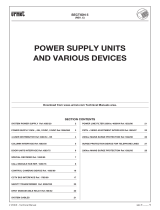
TiSwitchboardDevice
Software Manual
16
Communication:
Allows access, via the main menu page, to a set of video door entry functions and programmings.
The keys also allow the activation of:
Direct call – intercommunicating call to the Internal Unit.
Activation – direct activation of the associated Entrance Panel door lock.
Address book – display of Internal Unit, Entrance Panel and Switchboard address books.
Camera/cyclical selection – direct activation of the camera associated with the Entrance Panel
and cyclically of the cameras in the system.
Handsfree – activation of the handsfree mode.
Alarms and notifications:
Allows the receiving and management of technical alarms from the apartments or public zones and
also notifications on power cuts, return of power and flat battery sent from the MyHome system
burglar-alarm units.
NOTE: the Switchboard manages the calls from all the riser Entrance Panels (or those installed
downstream of interface 346851) or backbone (Main Entrance Panels) but cannot display the
image of the riser Entrance Panels, for which the communication is audio only.
The communication will instead be audio video for the main Entrance Panels.
Integrations
For both one-level systems (MASTER) and two-level systems (BACKBONE and RISER) one can insert
one or more SLAVE Switchboards which will have the same functions as the Switchboards to which
they are associated, whether BACKBONE, RISER or MASTER.
SLAVE switchboard in Day mode





















